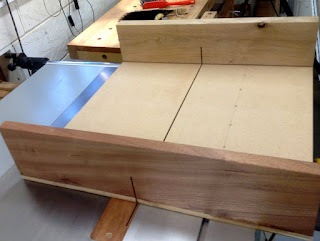The one I use all the time for mahogany is a oil based thixotropic pore sealer called Jecofil made by W.S. Jenkins & Co Limited. The one I'm using for this project is Jecofil JO27 Mahogany.
This is a coloured sealer that is first applied with a foam brush with the grain. Then you work accross the grain with the foam brush to prevent it being pulled. out. The spirit in the sealer evaporates but before that you simply wipe across grain with a rag. It tints the pores slightly and the mahogany one I'm using gives a slight red/brown colour to the timber.
The sealer has the consistency of mud when stirred and it is very time consuming to do. The results when you apply finish though are simply stunning it is well worth doing.
I applied it to all the show surfaces of each table, the tops, intermediate tops and the drawer fronts. W.S.Jenkins also make Jekofil for oak but I left the secondary oak wood of the drawers natural and unfilled.
Finish.
I decided on this project to use my dwindling supplies of Arm R Seal semi gloss. After pore filling and leaving overnight I lightly sanded with 400 grit just to provide a key. This got rid of any rough bits of Jecofil that may have been remaining on the surface.Then I gave each part of the project 2 coats of wipe on Seal-A-Cell (according to General Finishes best results with wipe on Arm-R-Seal are with SAC on first! - not me speaking :) )
After rubbing down between coats with 600 grit with a mineral spirits lubricant to make sure that I got a smooth base layer I then applied two more coats of Arm-R-Seal. On the horizontal surfaces I gave them 2 more coats (6 coats in all on the horizontal surfaces).
Some photos after two coats of Seal-A-Cell are below. There isn't much colour variation in real life as there are in the pictures. Digital camera has lied!
 |
| Intermediate tops and one drawer |
 |
| Another drawer |
 |
| The tables |
 |
| The table tops |
The results of a wipe on finish are stunning. You do have to watch for runs though and wipe them off before it cures. Good lighting is recommended when applying any finish. Once you have completed the job get out of the shop. Dust nibs can fall by air movement caused by you walking around in your shop - especially in the majority of home woodworkers non dedicated finish areas. As you build up coats the wood takes on more and more of a depth. Both seal r seal and arm r seal have tints and this changes the colour.
I left the finish to cure for 2 weeks before the next stage.
In a future project I will be using black Jecofil on an ash bodied 5 string bass guitar. You may be interest to see what happens to the wood grain on that project. I'm not sure myself but my customer was really stoked by the thought.

































